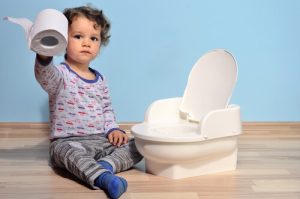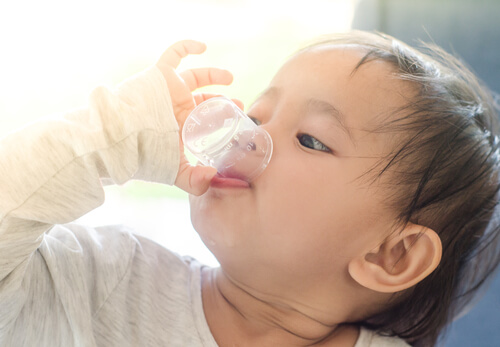Urinary Tract Infections in Childhood

Urinary tract infections (UTI) in childhood are very common. In fact, in children, they usually occur in the first three months of life. However, in girls, they can occur at any age.
Reoccurrences usually happen during the first 6 months. It’s important to know the clinical characteristics of urinary tract infections in childhood. That way, you can treat them properly according to your child’s age.
What Are Urinary Tract Infections?
A UTI is the invasion and multiplication of bacteria in the urinary tract. The main agent that causes it in both sexes is Escherichia coli. This is the second most common infection in children, just behind respiratory infections.
In general, the infection spreads. This means that the microorganisms that come from the intestine travel through the urethra until they reach the bladder.
Main Symptoms
The symptoms depend on the severity and the area the infection takes place. It can be in the kidneys, bladder, ureters or urethra.
- When it occurs in the bladder, it’s called cystitis. The common symptoms are lower abdominal pain, cloudy urine color, strange odor, the constant need to urinate, burning sensation, and blood in the urine.
- If it affects the kidneys, it’s called pyelonephritis. Unfortunately, if you don’t treat it early, it can damage your kidneys. Symptoms include chills, fever, lower back pain, nausea, vomiting, and reddened skin.
- Babies clearly can’t explain how they feel. However, they will show symptoms like irritability, lack of appetite, vomiting and fever.
Most Common Causes
There are many reasons why harmful bacteria can show up in this area and cause infections. Some of these causes include:
- Not urinating frequently enough.
- Wearing tight clothes.
- Nervous system diseases that make it difficult to urinate.
- Poor hygiene when going to the bathroom. For example, in women, this can be wiping from back to front.
- Constant bubble baths or foams that can cause infections.
- Vesicoureteral reflux. This consists of urine returning to the ureters and kidneys.

Treatment
Urinary tract infections in children are treated with antibiotics according to their age. In addition, they should always be checked out by a specialist. Then, the specialist will determine if the child will need to be hospitalized to get intravenous antibiotics.
It’s important that the child drinks plenty of water during treatment. If the symptoms disappear, the doctor may prescribe low doses of antibiotics. However, if the symptoms reappear, take your child to the doctor immediately.
You should choose antibiotic treatment according to the resistance of germs and previous treatments. If it’s the right one, it can stabilize the urine in 24 hours.
If the infection is not systemic, the treatment is 7 to 10 days. Some possible medications are:
- Nalidixic acid 55 mg / kg / day.
- Cephalexin 50 mg / kg / day.
- Nitrofurantoin 5-7 mg / kg / day.
- Trimetropin sulfa 5-7 mg / kg / day.
- Amoxicillin 50-100 mg / kg / day.
If the infection is systemic, the treatment will need to be 14 days. However, it may vary depending on the child’s age.
Newborns and children under 4 months:
- Ampicillin 75-100 mg / kg / day.
- Gemtamycin 7 mg / kg / day.
- Amikacin 15 mg / kg / day.
- Cefotaxime 100-150 mg / kg / day.
- Ceftriaxone 75 mg / kg / day.
For children over 4 months:
- Cefalotin 8-160 mg / kg / day.
- Cephradine 50-100 mg / kg / day.
- Ceftriazone 75 mg / kg / day.
- Cefotaxime 100-150 mg / kg / day.
If the germs are resistant:
- Aztreona or amikacin.

How to Prevent Urinary Tract Infections in Childhood
Since microorganisms entering the bladder from the anal area is the main cause of infection, it’s possible to prevent getting UTI’s. However, you can lower your child’s risk by following these tips:
- Put them in underwear that is soft, cool and loose.
- Change their diapers frequently.
- Keep their genitals clean.
- Teach them hygiene habits as soon as they are old enough.
- Make sure they drink plenty of liquids.
- Explain to them once they’re older that they should go to the bathroom several times per day.
With these recommendations, you’ll reduce the chances of your children having urinary tract infections.
Despite being extra careful, children frequently get infections. You can treat them with antibiotics under medical supervision.
All cited sources were thoroughly reviewed by our team to ensure their quality, reliability, currency, and validity. The bibliography of this article was considered reliable and of academic or scientific accuracy.
- Cavagnaro, F. Infección urinaria en la infancia. Infectología Práctica. Rev Chil Infect 2005; 22 (2): 161-168. [En línea].
- González Rodríguez JD, Rodríguez Fernández LM. Infección de vías urinarias en la infancia. Protoc diagn ter pediatr. 2014;1:91-108.
- Pinzón-Fernández MV, Zúñiga-Cerón LF, Saavedra-Torres JS. Infección del tracto urinario en niños, una de las enfermedades infecciosas más prevalentes. Rev. Fac. Med. 2018;66(3):393-8. doi: http://dx.doi.org/10.15446/revfacmed.v66n3.59978.
This text is provided for informational purposes only and does not replace consultation with a professional. If in doubt, consult your specialist.
